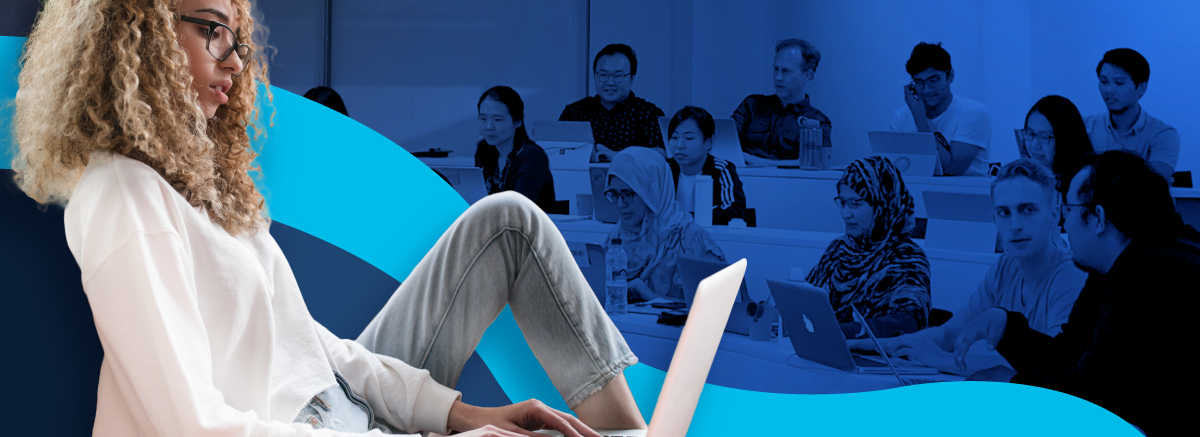Sudden change is never easy. So, it’s no secret that the abrupt shift to distance learning last year caused some tough challenges.
At the same time, important lessons were learned, creative thinking prevailed in all kinds of educational areas, and some strong advantages to remote learning emerged — when it’s done right and with great technology.
As we move toward the “next” normal, with more and more students returning to classrooms and university campuses, it will be important to blend the best of both worlds — virtual, on-campus, and in-class — in innovative ways.
I believe that this hybrid learning model is the way of the future. And it presents opportunities to redress educational imbalances and shortcomings rooted in centuries-old practices. This will demand imaginative new approaches to learning that better prepare students of all backgrounds and learning styles for a fast-changing world. And it will need next-level technology — especially collaboration tools that build in flexibility, inclusivity, and security.
At the university level, students were moving toward a hybrid model even before the pandemic. As with office workers, many expect greater choice in what they learn and how they do it. Some will want to be on campus full time; others will prefer to combine the learning experience with work, internships, or travel. At the same time, students will seek the right balance between alone/focus time, group work, or one-on-one interactions with other students and teachers.
For a generation of digital natives, virtual collaboration and learning come naturally. Many are visual or kinesthetic/tactile learners, so the drone of an auditory-only lecture may not work for them. The best collaboration platforms, however, will accommodate all styles of learning.
At Cisco, we see this yearning for new educational models in a program called Future Voices. It’s a platform on which educators and students can express their ideas about reimagining education — and innovative technology is a key topic of conversation.
Webex, for the challenges of the pandemic, and beyond
That’s why I’m excited about the latest innovations in Cisco Webex. This cloud-first tool proved indispensable during the pandemic, as so many schools around the world made the abrupt transition to remote learning. Webex offered superior security to protect against the kinds of online intrusions that upended too many lessons held on less-secure platforms. And with everything from visual smartboards and breakout rooms to instant messaging and AI-powered meeting transcriptions, it allowed schools to maintain high levels of continuity during a trying time.
Italy’s Luiss University is one school that was well prepared for the pandemic. Having already worked with Cisco and its partners to modernize the school’s network foundation, migrate its servers to the cloud, and adopt innovative learning tools like Webex, the university was able to scale its remote learning immediately after the pandemic hit Italy early last year.
Sudden change is never easy, but Luiss weathered this storm as well as any school. It has conducted more than 10,000 classes online since the pandemic began. And student-teacher engagement has actually scored higher since the pandemic.
Moreover, Luiss University is looking to keep many of the new teaching methods that have evolved over the past year, once the pandemic abates. They even have their own name for this next-phase strategy: a “phygital” learning environment that combines remote teachers and students with the brick-and-mortar lecture-hall experience.
Supporting an inclusive future for universities
Webex’s latest innovations will take hybrid education to the next level. The future of education will be all about flexibility, choice, and safety. And Webex is the most secure and flexible platform, with the goal of making the virtual experience 10x better than in-person. So, no remote student or worker ever feels less than fully connected.
To accomplish this, Cisco has added features like AI-powered transcription and real-time translation. Now, collaboration can transcend not just geographic but language barriers. Webex also connects with other apps and service, like Facebook’s Workplace, and it integrates instant messaging, phone, and other modes of communication into one platform. Combined with smartboards and other features, that enables all kinds of learning.
The campus experience will remain an important growth experience for many students. But I look forward to a future in which students from all economic backgrounds, cultures, and regions can learn from one another and gain new educational opportunities; students can check in remotely to lectures when the need arises; and they can tailor their education to better fit their own learning styles and life situations.
And they can do it all knowing that they are secure. At the university level, many institutions conduct important research, so security is paramount. But personal privacy is just as important, so Webex builds in encryption and high security at every level of design, coding, and usage.
More than ever, the world needs educated, creative thinkers. But for far too long, millions of people have been locked out of the opportunities afforded by higher education. By opening doors to more students, we will tap new sources of talent and perspective, if not outright genius.
I believe that hybrid learning models will better enable schools to develop young minds that are ready to tackle our biggest challenges. And great technology will support them every step of the way.
###
